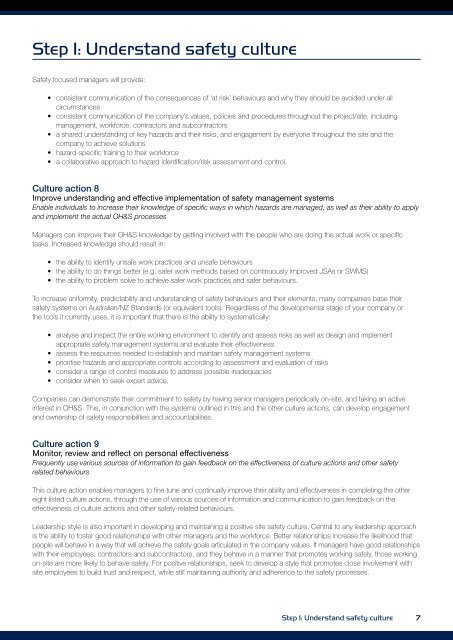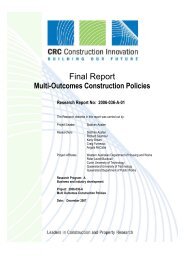A Practical Guide to Safety Leadership Book (PDF 5MB) - QUT ePrints
A Practical Guide to Safety Leadership Book (PDF 5MB) - QUT ePrints
A Practical Guide to Safety Leadership Book (PDF 5MB) - QUT ePrints
Create successful ePaper yourself
Turn your PDF publications into a flip-book with our unique Google optimized e-Paper software.
Step 1: Understand safety culture<br />
<strong>Safety</strong> focused managers will provide:<br />
• consistent communication of the consequences of ‘at risk’ behaviours and why they should be avoided under all<br />
circumstances<br />
• consistent communication of the company’s values, policies and procedures throughout the project/site, including<br />
management, workforce, contrac<strong>to</strong>rs and subcontrac<strong>to</strong>rs<br />
• a shared understanding of key hazards and their risks, and engagement by everyone throughout the site and the<br />
company <strong>to</strong> achieve solutions<br />
• hazard-specific training <strong>to</strong> their workforce<br />
• a collaborative approach <strong>to</strong> hazard identification/risk assessment and control.<br />
Culture action 8<br />
Improve understanding and effective implementation of safety management systems<br />
Enable individuals <strong>to</strong> increase their knowledge of specific ways in which hazards are managed, as well as their ability <strong>to</strong> apply<br />
and implement the actual OH&S processes<br />
Managers can improve their OH&S knowledge by getting involved with the people who are doing the actual work or specific<br />
tasks. Increased knowledge should result in:<br />
• the ability <strong>to</strong> identify unsafe work practices and unsafe behaviours<br />
• the ability <strong>to</strong> do things better (e.g. safer work methods based on continuously improved JSAs or SWMS)<br />
• the ability <strong>to</strong> problem solve <strong>to</strong> achieve safer work practices and safer behaviours.<br />
To increase uniformity, predictability and understanding of safety behaviours and their elements, many companies base their<br />
safety systems on Australian/NZ Standards (or equivalent <strong>to</strong>ols). Regardless of the developmental stage of your company or<br />
the <strong>to</strong>ols it currently uses, it is important that there is the ability <strong>to</strong> systematically:<br />
• analyse and inspect the entire working environment <strong>to</strong> identify and assess risks as well as design and implement<br />
appropriate safety management systems and evaluate their effectiveness<br />
• assess the resources needed <strong>to</strong> establish and maintain safety management systems<br />
• prioritise hazards and appropriate controls according <strong>to</strong> assessment and evaluation of risks<br />
• consider a range of control measures <strong>to</strong> address possible inadequacies<br />
• consider when <strong>to</strong> seek expert advice.<br />
Companies can demonstrate their commitment <strong>to</strong> safety by having senior managers periodically on-site, and taking an active<br />
interest in OH&S. This, in conjunction with the systems outlined in this and the other culture actions, can develop engagement<br />
and ownership of safety responsibilities and accountabilities.<br />
Culture action 9<br />
Moni<strong>to</strong>r, review and reflect on personal effectiveness<br />
Frequently use various sources of information <strong>to</strong> gain feedback on the effectiveness of culture actions and other safety<br />
related behaviours<br />
This culture action enables managers <strong>to</strong> fine tune and continually improve their ability and effectiveness in completing the other<br />
eight listed culture actions, through the use of various sources of information and communication <strong>to</strong> gain feedback on the<br />
effectiveness of culture actions and other safety-related behaviours.<br />
<strong>Leadership</strong> style is also important in developing and maintaining a positive site safety culture. Central <strong>to</strong> any leadership approach<br />
is the ability <strong>to</strong> foster good relationships with other managers and the workforce. Better relationships increase the likelihood that<br />
people will behave in a way that will achieve the safety goals articulated in the company values. If managers have good relationships<br />
with their employees, contrac<strong>to</strong>rs and subcontrac<strong>to</strong>rs, and they behave in a manner that promotes working safely, those working<br />
on-site are more likely <strong>to</strong> behave safely. For positive relationships, seek <strong>to</strong> develop a style that promotes close involvement with<br />
site employees <strong>to</strong> build trust and respect, while still maintaining authority and adherence <strong>to</strong> the safety processes.<br />
Step 1: Understand safety culture 7

















